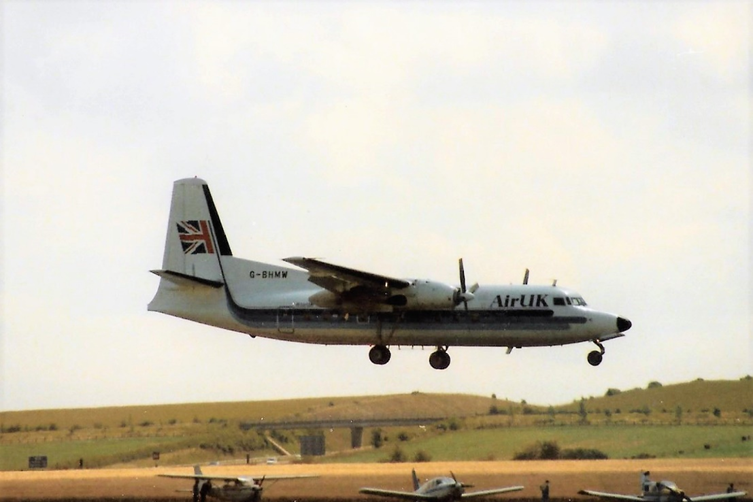


Back in the 1950s many manufacturers were looking hungrily at the DC-3 replacement market. So many examples of the Douglas design were in operation around the world it was generally thought there would be huge profits to be made in providing their replacement. As it happened, many of these old Douglas planes just flew on and on. Here in the UK Handley Page and Avro both threw their hats in the ring with the Herald and Avro 748, but the main beneficiary in the DC-3 replacement game came from across the North Sea in the Fokker factory at Amsterdam in the Netherlands. With funding help from the Dutch Government Fokker had been designing their new twin turboprop airliner the F-27 Friendship. Powered by two Rolls Royce Darts and using the REDUX bonding technique perfected by de Havilland on the Comet, the 28-passenger prototype first flew in November 1955. Test flights showed there was a tail-heavy balance problem so the forward fuselage was lengthened on the second aeroplane to correct this. This stretch also gave the added advantage of providing space for more seats giving a passenger capacity of 32. It was to be three years later in November 1958 before the new aeroplane finally entered service for the first time, Aer Lingus were the launch customer.

Production of the F-27 in its many different variants ran from 1955-1987 seeing 592 built by Fokker. This however was not the full story as Fokker had entered into an agreement with US company Fairchild in 1966 for them to licence-build the aeroplane for sales mainly in the US. This added another 128 Fairchild-built F-27s plus a further 78 of the Fairchild-designed stretched version called the FH-227 bringing the total to almost 800 aeroplanes, streets ahead of any competitor in the same market. The stretched FH-227 idea was copied by Fokker to make their own F-27-500 variant which was six feet longer than the original Friendship. The Fairchild F-27 differed from its Dutch counterpart by having seats for 40 passengers, weather radar and larger fuel tanks.

The stretched FH-227 could accommodate 56 passengers. Most of these and the smaller Fairchild F-27 were delivered new to US airlines. The last major user of the type in the US was FedEx who operated a large number that had been converted to freighters. Sales of the Friendship were slow at first but once they entered service airlines could see their advantage over older piston engine types and by the early 1960s large orders were being placed for the Dutch machine. In 1960 a new Friendship could be purchased for £239,000. Sales came from all around the world. Here in the UK one of the largest operators was AirUk having taken over the old Air Anglia fleet. British Midland, Jersey European and Channel Express would also become major operators of the type.

Fokker planned to offer its airliner to the military and to this end produced the Troopship transport version and a variant dedicated to maritime reconnaissance. Several air forces took up these versions including the Dutch and Finnish Air Forces. For many years one of the Dutch Troopships was a regular at UK air shows giving a very exciting display complete with smoke trails from both engines.

As the airlines began to retire their passenger F-27s many were given a new lease of life and converted into small parcel freighters and operated by airlines such as Channel Express. However by the early 1980s sales of the Friendship were beginning to tail off so Fokker looked into producing a new version of the nearly 35 year-old design. Not wanting to change too much as the original concept had been such a hit with the airlines, it incorporated all the updates of the latest F-27s, added new Pratt and Whitney PW127 engines that used 30 per cent less fuel than the old Darts and mated these with six-blade Dowty propellers. Fokker gave the cockpit a makeover incorporating glass electronic instruments and a new CAT 2-capable flight control system. In the structure of the plane composite material was used where possible and modifications were made to the wing to make it more efficient. All in all there were so many changes Fokker renamed the aeroplane the Fokker F-50.

The first Fokker 50 took to the sky on 28 December 1985 and like its F-27 ancestor it was two years before it entered service, with German airline DLT, the launch customer. Production would run until the demise of Fokker in 1997. 213 examples were produced. By 2019 just 76 of these aeroplanes were still in commercial service around the world. From the F-50 Fokker developed the stretched F-60 freighter version with a 1.62 metre longer fuselage and a large forward cargo door. Only four examples were made, all going to the Royal Netherlands Air Force who in 2010 sold them on the Peruvian Navy.

By 1994 Fokker was running up big losses due partly to cost overruns on both the Fokker F-50 and the new Fokker F-100 jet combined with a drop off in orders for new aeroplanes. By the following year the manufacturer was in talks with the Dutch government about a bailout to keep the company going, this didn’t come about and in 1996 Fokker announced the end of F-50 production as it had become bankrupt. The following year the last ever example, which could trace its roots back to the Friendship of 1955, was delivered and Fokker was no more. 213 F-50s had been produced but with rising costs and stiff competition from the likes of the SAAB 340, ATR 42 and the Bombardier Dash-8 the Dutch plane had run out of steam. However add the 213 F-50s and 4 F-60s to the 592 F-27s plus the 206 Fairchild-built planes and it’s fair to say the 1015 examples built truly made the Friendship a Dutch master.

‘till the next time Keith
Registered Charity No. 285809